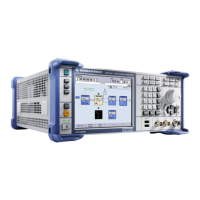Instrument Function
R&S
®
SMBV100A
451Operating Manual 1176.8016.02 ─ 17
The equipment options for the basic unit (R&S SMBV with frequency option
R&S SMBV-B10x) includes option R&S SMBV-K18 (Digital Baseband Connectivity)
and options R&S SMBV-B10/B51 (Baseband Generator).
The R&S SMBV is equipped with the follwoing input interfaces:
●
the I/Q connectors as input for the external analog signal
The external analog signals are internaly processed and A/D-converted.
●
the DIGITAL IQ IN at the rear of the instrument as input connector for the external
digital signal
This interface provides direct communication with other R&S instruments.
Additionally, the external digital signal interface module (R&S EX-IQ-BOX) can be
connected, providing parallel or serial signal transmission from external devices.
Note: The DIGITAL IQ IN/OUT interface is bi-directional and serves as signal input
or output. If you for example enable it as a signal input, the signal output is auto-
matically disabled, and vice versa.
The Chapter 5.10.2, "BB Input Block", on page 453 describes the settings for con-
figuring an input signal. Refer to Chapter 5.8, "Digital I/Q Output Settings",
on page 320 for information concerning signal output.
The signal source (typically a second R&S Instrument) and the receiving R&S Instru-
ment have to be synchronized.
Analog Wideband I/Q In and Baseband Input are not possible simultaneously and
therefore switch each other off. In addition to the I/Q impairments in the Impairments
block, it is also possible to set analog I/Q impairments in the I/Q Modulator menu of the
R&S SMBV.
5.10.1 Important Signal Parameters
The correct signal processing of the externally supplied input signals in the instrument
require information of some signal parameters, like sampling rate, crest factor and sig-
nal level, expressed as peak or as RMS level value.
●
Sample rate
The sample rate of the input signal can be defined manually or automatically
retrieved from the input signal.
●
Crest factor
Test setups may require feeding of external signal to the digital/analog input of the
R&S SMBV. As a rule, whenever an I/Q signal is transferred between two instru-
ment, the crest factor at the outputs of the "source" instrument has to match with
the crest factor at the inputs of the receiving one.
The crest factor gives the difference in level between the peak level and RMS level
value in dB (see Figure 5-29). The R&S SMBV uses the crest factor value by the
calculation of power levels. The general principle is, that the R&S SMBV compen-
sates the RMS levels of the externally supplied signal by the crest factor.
External Baseband Signal - Baseband Input

